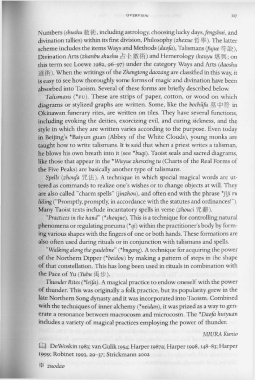Page 157 - The Encyclopedia of Taoism v1_A-L
P. 157
OVE RVIEW Il7
Numbers (shushu JJ&W, including astrology, choosing lucky days,fengshui, and
divination tallies) within its first division, Philosophy (zhexue tg-*). The latter
scheme includes the items Ways and Methods (daofa), Talismans (fujue f,fWc),
Divination Arts (zhanbu shushu d:i I" !Ji'!£W) and Hemerology (kanyu :f:i~; on
this term see Loewe 1982, 96-97) under the category Ways and Arts (daoshu
~ W) . When the writings of the Zhengtong daozang are classified in this way, it
is easy to see how thoroughly some forms of magic and divination have been
absorbed into Taoism. Several of these forms are briefly described below.
Talismans (*FU). These are strips of paper, cotton, or wood on which
diagrams or stylized graphs are written. Some, like the bochiifu JJ 9=t f,f in
Okinawan funerary rites, are written on tiles. They have several functions,
including evoking the deities, exorcizing evil, and curing sickness, and the
style in which they are written varies according to the purpose. Even today
in Beijing's *Baiyun guan (Abbey of the White Clouds), young monks are
taught how to write talismans. It is said that when a priest writes a talisman,
he blows his own breath into it (see *buqi). Taoist seals and sacred diagrams,
like those that appear in the *Wuyue zhenxing tu (Charts of the Real Forms of
the Five Peaks) are basically another type of talismans.
Spells (zhoufa % it;:) . A technique in which special magical words are ut-
tered as commands to realize one's wishes or to change objects at will. They
are also called "charm spells" (jinzhou), and often end with the phrase *jiji TU
lUling ("Promptly, promptly, in accordance with the statutes and ordinances!").
Many Taoist texts include incantatory spells in verse (zhouci % /A¥f).
"Practices in the hand" (*shoujue). This is a technique for controlling natural
phenomena or regulating pneuma (*qi) within the practitioner's body by form-
ing various shapes with the fingers of one or both hands. These formations are
also often used during rituals or in conjunction with talismans and spells.
"Walking along the guideline" (*bugang). A technique for acquiring the power
of the Northern Dipper (*beidou) by making a pattern of steps in the shape
of that constellation. This has long been used in rituals in combination with
the Pace of Yu (Yubu ~ 2t).
Thunder Rites (*leifa). A magical practice to endow oneself with the power
of thunder. This was originally a folk practice, but its popularity grew in the
late orthern Song dynasty and it was incorporated into Taoism. Combined
with the techniques of inner alchemy (*neidan), it was prized as a way to gen-
erate a resonance between macrocosm and microcosm. The *Daofa huiyuan
includes a variety of magical practices employing the power of thunder.
MIURAKunio
m De Woskin 1983; van Gulik 1954; Harper 1987a; Harper 1998, 148- 83; Harper
1999; Robinet 1993, 29-37; Strickmann 2002
* zuodao

